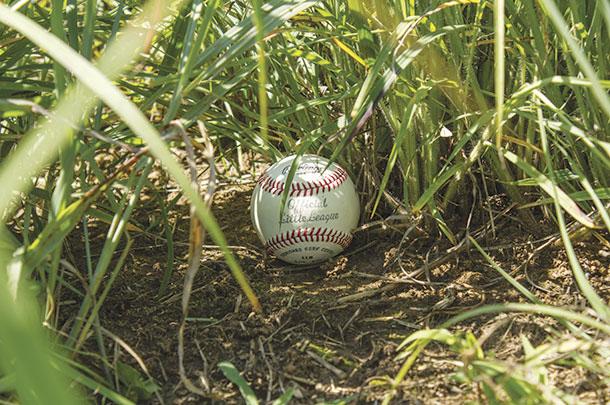Earlier this year, he gave a presentation titled “Imperiled Grasslands Wildlife and Grazing – the Good, the Bad and the Ugly” at the Southern Pasture and Forage Crop Improvement Conference in Knoxville. In follow-up to that presentation, and for those working to increase grassland birds in pastures, I asked Brazil to highlight portions of his presentation.
In your presentation, you said, ‘Just because you have grass doesn’t mean you have habitat,’ and ‘Food is important – but less so than structure.’ Can you explain more about that concept?
BRAZIL: When it comes to grassland birds, not all grasses are created equally. Grassland birds, such as bobwhite quail, eastern meadowlarks and dickcissels, require specific types of vegetation structure for nesting, brood-rearing, foraging and other daily activities.

For instance, tall fescue, while a valuable forage for cattle production, provides poor habitat for most grassland birds. Traditional management of tall fescue results in a dense sod with very little bare ground between grass plants. Bare ground is essential because it allows birds to move through the pasture to find food and cover. This is especially true for tiny, flightless, bobwhite chicks.
The availability of nesting sites in the breeding season is another important consideration for habitat. Many grassland birds rely on bunchgrasses for nesting.
Bunchgrasses provide material and a place for building the nest while also shielding it from view of predators. The upright growth form of native warm-season grass species such as big bluestem and little bluestem provide excellent nesting clumps. Bermudagrass, on the other hand, has a prostrate growth form and forms a dense sod.
Why is food less important than structure? In the absence of proper vegetation structure, breeding grassland bird use of a pasture will be low or non-existent, regardless of the amount of food available.
Is grazing with native birds compatible?
BRAZIL: Absolutely. Grassland birds evolved with grazing, and their habitat depends on it. This is especially true in areas of the eastern U.S. which receive large amounts of average annual rainfall. Disturbance in these environments is necessary to keep grass from becoming too tall and thick.
Historically, grasslands were maintained by the combined disturbances of grazing and fire. These disturbances kept woody vegetation at bay and maintained the grass structure preferred by birds. Without disturbance, grasslands become overgrown, leading to a decline in both habitat and forage quality, and ultimately transition into shrublands or even woodlands.
Unfortunately, due to liability concerns and a general lack of familiarity with fire among landowners, use of this effective tool is becoming increasingly uncommon on most grasslands. In the absence of fire, grazing is the only readily available – and most practical – natural disturbance tool available to managers. While including some prescribed fire is best, grassland habitat for many bird species can be maintained with proper grazing alone in conjunction with the judicious use of herbicides.
Which type of grazing is better for grassland birds? Why?
BRAZIL: Any grazing system that produces the appropriate vegetation structure is fine. Generally speaking, picking a grazing system starts with choosing either continuous or rotational stocking. There are too many variables to consider when choosing between the two to list here, but for grassland birds, I tend to prefer continuous stocking for several reasons. First, rotational stocking results in more uniform vegetation structure within a paddock.
In terms of forage utilization, that’s not a bad thing, but birds require more structural diversity. Changes in vegetation structure are also more dramatic, frequent and rapid with rotational than continuous stocking. This is because, even if stocking rates are the same for both continuously and rotationally grazed pastures, the stocking density for the paddock currently being grazed within a pasture is greater in rotational systems.
If rest periods are not long enough, there may not be sufficient time for vegetation structure to recover and a bird to complete a full nesting cycle (36 to 40 days for many species) before the paddock is grazed heavily again, rapidly altering the vegetation structure.
Continuous grazing also affects vegetation structure but in a slower, less uniform manner. This gives birds a better chance to complete nesting attempts and provides a more diverse vegetation structure. Rotational grazing can also work for grassland birds given sufficient rest periods for paddocks.
If a pasture is hayed because grass gets ahead of the stock, what does that do to bird establishment and how can producers mitigate that impact?
BRAZIL: Active bird nests are almost always destroyed during haying operations; there’s really no way around it. A compromise often recommended is to put off haying until mid-July to allow birds to safely complete at least one nesting cycle.
Unfortunately, hay harvested for the first time in mid-July will be low-quality. If you can afford to wait and harvest low-quality hay, it will definitely benefit birds. That’s not a luxury many farmers have, though.
Another option is to leave odd areas, strips or pasture borders uncut to maintain some habitat. However, the effectiveness of this technique is debatable unless wide strips or large areas are left uncut. A final option worth considering is planting a grass such as indiangrass that is later-maturing, allowing hay to be cut at a later date, providing more time for birds to complete an initial nesting cycle.
The bottom line is: It’s not always possible to meet the needs of wildlife within the context of agricultural production. In terms of haying, it really boils down to how much you can afford to strike a compromise between hay production and habitat.
What are some ‘small’ management changes producers can make to improve bird habitat that won’t largely impact profitability?
BRAZIL: A standard recommendation for fescue belt beef cattle producers is to incorporate a perennial warm-season grass into forage systems. Farmers interested in both cattle production and grassland birds should consider choosing a native grass to fill this role in their forage production program.
These grasses provide low-input, profitable cattle gains as well as grassland bird habitat. My favorite dual-purpose native grass mix is big bluestem, indiangrass and little bluestem. Grassland birds aren’t the only wildlife that will benefit; deer and turkey will also.
As a bonus, native warm-season grasses help mitigate drought risk and reduce supplemental feed requirements. This isn’t necessarily a “small” management change, but it is one that will pay dividends for both cattle and birds.
Another change that can significantly improve nest success in rotational grazing systems is resting paddocks for as long as possible between grazing periods to allow vegetation to recover sufficiently to provide nesting cover, nesting attempts to be initiated and completed, and fledglings to mature enough to fly to avoid haying machinery.
Allowing pastures to become slightly weedier than normal will also increase their utility for grassland birds. Noxious and invasive weeds must be controlled before they become problems. In their absence, however, other weeds such as ragweed and croton could be allowed to increase somewhat with very minimal loss of forage or beef production. ![]()
PHOTO 1: Kyle A. Brazil
PHOTO 2: Native bunchgrasses such as big bluestem and indiangrass provide grassland birds with nesting habitat, concealment and bare ground for travel and foraging. A baseball should be able to roll along the ground yet still be hidden from view. Photo by Jacob Wessels.
Email Kyle Brazil for more information.

-
Lynn Jaynes
- Editor
- Progressive Dairyman
- Email Lynn Jaynes











